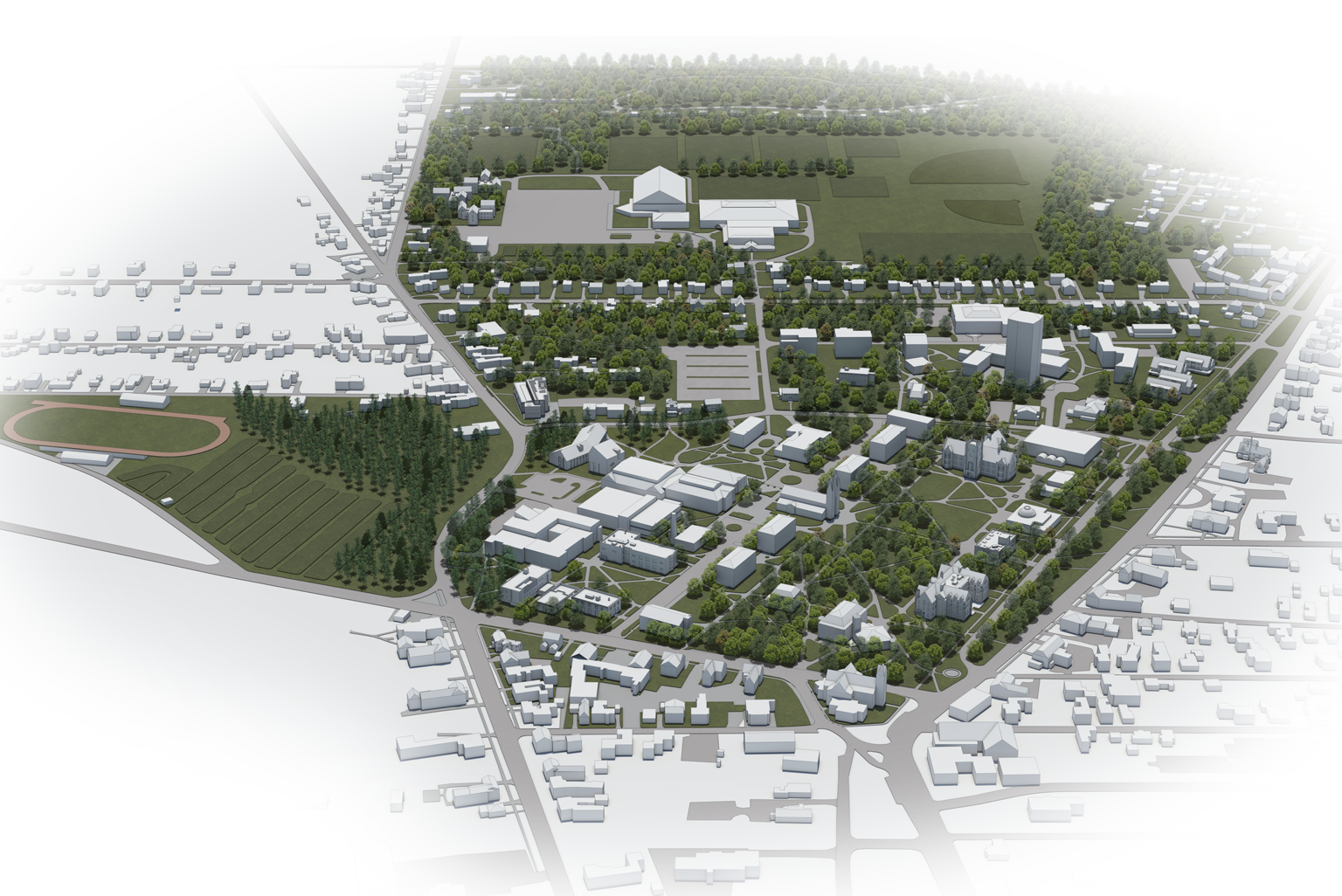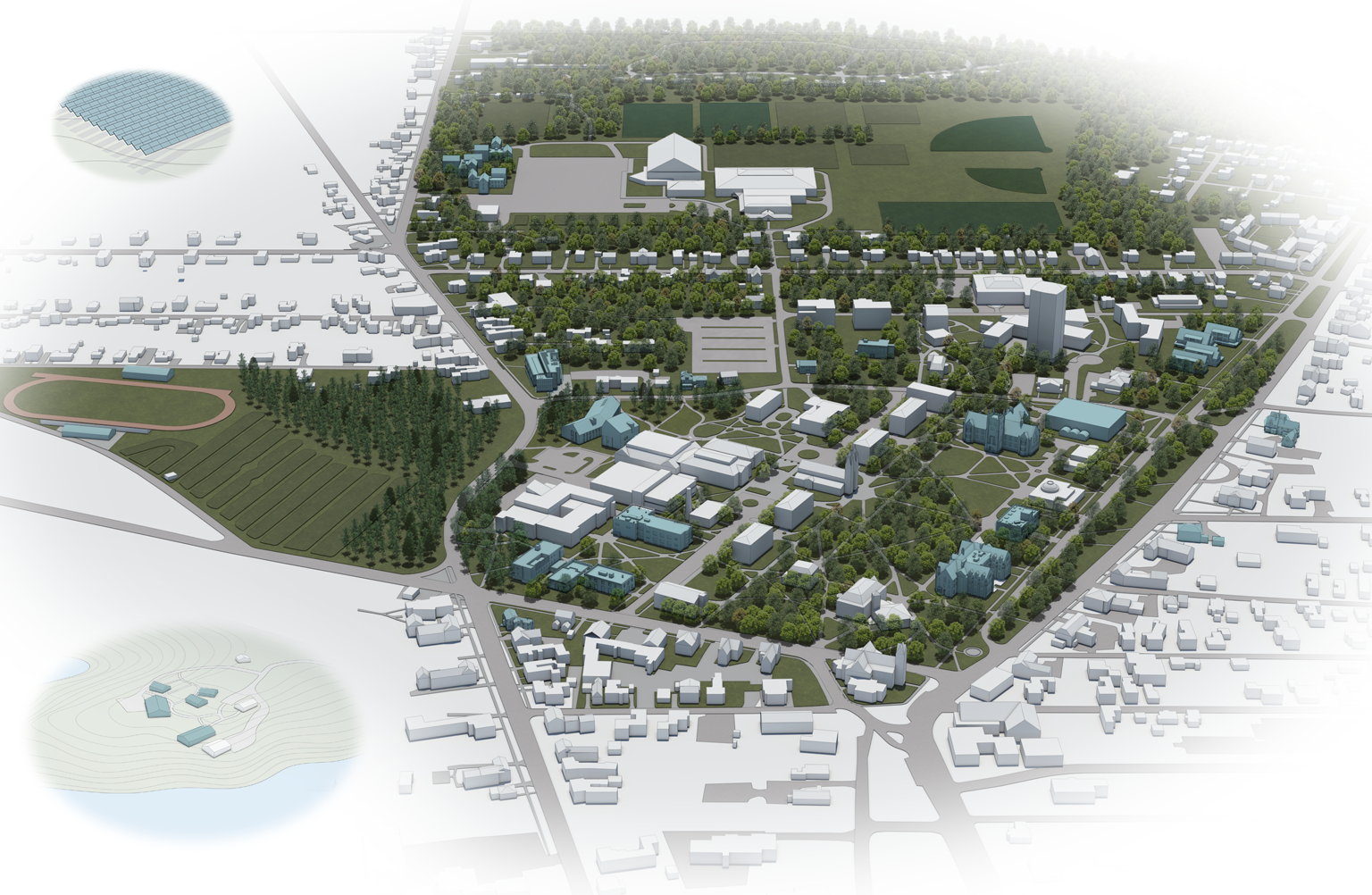Bowdoin Campus Evolution
Visit the interactive presentation of this content.
President’s Statement
“To walk through the Bowdoin campus is to walk through the history of American architecture. The student, who President Hyde hoped would learn ‘to count art an intimate friend,’ lives daily with that opportunity. The very campus is part of the liberal arts experience at Bowdoin.”
—A. LeRoy Greason
More than three decades have passed since Bowdoin’s twelfth president wrote those words, and they still hold true today. We work to balance the timeless beauty and unique character of our campus with the ever-changing needs that come with providing a great Bowdoin education. We couple this with our enduring commitment to sustainability and renewal to drive our campus planning efforts. I hope this presentation provides a sense of how we are meeting these goals, and how we will continue to protect and enhance the Bowdoin campus in the years to come.
— Clayton Rose
In Progress: Bowdoin Campus Evolution (2018–2025)

The most recent update to the original 2003 campus development plan was adopted in October 2017, setting the objectives for strengthening the character and quality of the campus experience for the near and medium term (2018–2025) within the context of a long-range vision and framework. A key premise underlying the priorities was to achieve our goals by renovating within our existing footprint whenever possible. With some necessary exceptions—upperclass housing, the Schiller Coastal Studies Center, and need for large classrooms and more lab space, among others—many of the programmatic challenges were to be addressed through the adaptive reuse and reconfiguration of facilities.
With Barry Mills Hall and the John and Lile Gibbons Center for Arctic Studies buildings taking shape, the College has realized roughly half of the priorities outlined in the plan. This interactive timeline tool is designed to enable the user to look back on projects completed since 2017 and to preview the projects that are planned for the next couple of years.
The process to complete the next update to the campus development plan will begin in 2024 with a focus on priorities five to eight years beyond 2025.
This interactive experience is intended to highlight the evolution and direction of the Bowdoin College campus from 2018 to 2025 in six key areas.

Academic and Administrative Office Realignment (AAR)
Renovations and relocations serving to create a more cohesive alignment of academic departments, reducing the number of faculty separated from their departments and accommodating the needs of expanding programs and offices such as THRIVE and counseling services.

Sustainability (SUS)
Efforts in support of Bowdoin’s Sustainable 2042 Plan to reduce campus carbon emissions and, wherever possible, to implement sustainable building designs (e.g., passive house) to maximize building efficiency.

Teaching and Learning Initiatives (TLI)
These projects increase the availability of large, flexible classrooms to foster active learning and create more space for research labs in the sciences, with an emphasis on the interdisciplinary teaching and study of the environment.

Renovation and Adaptive Reuse (RAR)
Supports the College’s objective to repurpose existing space to support emerging programmatic needs and to address a backlog of deferred maintenance.

Student Life Initiatives (SLI)
Expansions and renovations to replace outdated housing and to meet the demand for independent, apartment-style living with single bedrooms for upper-class students, to relieve the pressure on existing athletic fields and facilities from increases in athletic and recreational activities, and to increase opportunities for social interaction.

Accessibility and Inclusion (ACC)
Eliminates barriers to inclusion for community members with disabilities, meets applicable design and accessibility standards under the Americans with Disabilities Act (ADA), and incorporates universal design thinking.
2018
Roux Center for the Environment
The Roux Center for the Environment supports faculty and students across the environmental disciplines at Bowdoin. Its design is intended to facilitate new ways of teaching, learning, and scholarship.
Teaching and Learning Initiatives
The Roux Center for the Environment, a three-story, 2,916-square-foot academic building located at the corner of Harpswell Road and College Street, was made possible through the generosity of David and Barbara Roux P’14, who wished to foster a home for interdisciplinary teaching and learning around myriad aspects of the environment. The Roux Center houses the Department of Earth and Oceanographic Science and the Environmental Studies Program and comprises classrooms, teaching and research labs, faculty offices, conference rooms, and common spaces, including The Janet B. Perper Lantern—the atrium-auditorium that is the front and heart of the Roux Center and is designed to be both a hub and refuge for the Bowdoin community.
Accessibility and Inclusion
All three floors are fully accessible via a central elevator and include accessible bathrooms, classrooms, and classroom labs. All counter heights, work surfaces, sinks, fume hoods, and other fixtures are designed to meet or exceed ADA standards. A gender-inclusive bathroom is available on the first floor.
Sustainability
The Roux Center is a LEED platinum-certified building, a rarity for a science building due to the energy required for laboratory fume hoods. To mitigate the demand on the HVAC system to provide make-up air to the labs, the College installed ductless fume hoods that contain filters that clean contaminated air and recirculate it directly back into the laboratory, requiring much less energy. The building includes a green roof designed to alleviate “heat islands” and to soak up rainwater for recirculation. The rooftop solar panels provide 35-megawatt hours per year, or roughly 20 percent of the building’s electricity. Rainwater is collected and stored in a 2,000-gallon tank in the basement and then filtered and pumped to restrooms for flushing.
Boody-Johnson House
The Boody-Johnson House was designated a Registered Historic Landmark in 1975 and was renovated to become part of the College House system. It received a Maine Preservation Honor Award in 2020.
Student Life Initiatives
Renovations to the historic Boody-Johnson House created accomodations for twenty-six students, mostly sophomores, in room configurations that include singles, doubles, and triples. A patio, living spaces, laundry room, and a contemporary kitchen were all provided, along with a generous two-story social space created in the attached Chase Barn structure.
Accessibility and Inclusion
A limited use/limited application (LU/LA) elevator was added to support access to the second story of the Chase Barn. All bathrooms, and the kitchen, laundry rooms, and an upgraded exterior ramp were made ADA-compliant.
Sustainability
Single-pane windows were replaced with high-energyefficient windows and R-38 insulation was added to the previously uninsulated attic.
Renovation and Adaptive Reuse
This latest transformation of the Boody-Johnson House took what was home to gender, sexuality, and women’s studies (GSWS) and created a dynamic residential and social space for students while maintaining the historic character of the house. Its location on the west side of Maine Street bookends the corridor of college houses that includes Quimby, MacMillan, Burnett, Helmreich, and Howell House. Meanwhile, GSWS’s relocation to Ham House on Maine Street joins the row of academic departments along Bath Road (Pols, Riley, Copeland).
2019
Whittier Field improvements (Phase I)
The Whittier Field athletic complex, home to Bowdoin’s football, men’s and women’s outdoor track and field, and men’s lacrosse teams, underwent a two-phase renovation project that was completed in 2019.
Student Life Initiatives
The first phase of the project began in May 2017 and included replacing the existing grass field with artificial turf and adding lights, seating, and a new press box, along with an expansion of the current six-lane track to the eight lanes required to host championship track meets. The project also included the restoration of the original footprint of Hubbard Grandstand through the removal of bleachers that were added over the years.
Accessibility and Inclusion
The new grandstand includes a ramp to an elevated platform with wheelchair spaces and companion seats for viewing athletic events.
Whittier Field improvements (Phase II)
Phase II of the Whittier Field project included the construction of a support facility that houses locker, training, and equipment rooms and public restrooms. Also included in the scope is the completion of the east end of the bleacher system installed fall 2017.
Sustainability
The 8,780-square-foot support building is LEED certified and consumes 44 percent less energy than a typical building of its size and type due to the energy conservation employed in the construction of the roof, walls, flooring and window assemblies, and building systems. Due to optimally engineered ventilation systems, and the selection of low-VOC (volatile organic compounds) paint, carpeting, and furniture finish, the support building has excellent indoor air quality.
Accessibility and Inclusion
The support building contains two locker rooms with accessible lockers, showers, and restrooms. Accessible public restrooms were added for use during sporting events. New paved pathways and grades connect the support building to the field and grandstands. The new grandstand includes a ramp to an elevated platform with wheelchair spaces and companion seats for viewing athletic events.
Park Row Apartments
Park Row Apartments, four three-story Passive House buildings that opened in 2019, house eighty-eight students in suite-style apartments.
Student Life Initiatives
Each of the four buildings has suite-style units for blocks of four, six, and eight students with a full kitchen, living room, bathroom, study area, third-floor shared laundry, a single bedroom for each resident, and full-service elevators making living spaces accessible to all. One of the four buildings has a full basement for student programming and storage. The houses all feature covered porches that run the length of each building. Park Row Apartments received the AIA New Hampshire Excellence in Architecture Honor Award in 2020.
Sustainability
The buildings were developed to achieve passive-house certification with thick—or “super”—insulation, triple-pane windows, and efficient energy-recovery air-exchange systems, leading to a 50 percent reduction in energy use as compared to traditional construction methods.
Accessibility and Inclusion
Each residence is fully accessible, with elevator access to each floor.
2020
Harpswell Apartments
The Harpswell Apartments consist of three forty-four-bed residence halls located at 80 Harpswell Road, to the east of Watson Arena and Farley Field House.
Student Life Initiatives
The Harpswell Apartments deliver the kind of independent living experience that upperclass students desire. Each apartment features all single bedrooms, a full kitchen, bathrooms, and living areas. The three buildings surround a landscaped center courtyard. Each has a common area for student programming and informal gatherings. The project received a 2021 AIA New Hampshire and 2022 AIA Maine Excellence in Architecture Honor Award.
Sustainability
The building envelopes were designed to meet Passive House standards with thick, “super” insulation, triple-pane windows, and efficient air-exchange systems, leading to a 50 percent reduction in their energy use as compared to traditional construction methods. The complex is fossil-fuel-free, utilizing 100 percent renewable electricity for heating and ventilation systems.
Accessibility and Inclusion
All twenty-one apartments are fully accessible, with elevator access to the second floors, where laundry facilities are located.
Schiller Coastal Studies Center
With the expansion of the Schiller Coastal Studies Center, located about thirteen miles from the Bowdoin campus, the 118-acre Harpswell facility now offers an even wider range of possibilities for students and researchers studying the ocean and the environment and the coast of Maine.
Teaching and Learning Initiatives
With the construction of new facilities at the Schiller Coastal Studies Center from May 2019 until August 2020, the College completed a significant expansion of opportunities for students and researchers. The project included construction of a single-story, 4,200-square-foot dry lab with teaching, research, and preparation lab and support spaces, as well as a single-story, 4,950-squarefoot Living and Learning Center (LLC), which provides spaces for classes, conferences, and dining. The residential component consists of three 1,800-squarefoot, six-bedroom cabins, and a 950-square-foot apartment cabin. The accessible location and diversity of natural habitats open up a wide range of marine, estuarine, and terrestrial research, and teaching possibilities.
Sustainability
The LLC, cabins, and apartment building were all designed to Passive House standards, and the LLC received Passive House Institute US (PHIUS) certification in 2021. They are “super”-insulated and airtight, with triple-paned windows, and are set up with ventilation systems and, in many cases, heat pumps for heating and cooling. Part of what makes these structures so efficient is the ventilation system, which recovers heat from exhausted, stale air to pre-heat incoming fresh air while also removing humidity.
Accessibility and Inclusion
The expansion of the Schiller Coastal Studies Center included three accessible cabins and one apartment, with kitchens, bathrooms, and bedrooms. The LLC includes accessible restroom, seminar, pantry, and common spaces. The new Schiller dry lab has accessible-height laboratory benches, sinks, and fume hood. New paved walkways connect the apartment, cabins, LLC, dry lab, and Leighton Sailing Center buildings with accessible routes.
2021
Hatch Science Library
A renovation within the Hatch Science Library completed in 2021 created two large classrooms and updated an existing seminar room.
Teaching and Learning Initiatives
The Hatch Science Library maintains a collection in subjects relating to biochemistry, biology, chemistry, computer science, environmental studies, earth and oceanographic science, mathematics, neuroscience, physics, and astronomy. Materials held at Hatch Science Library—including books, journals, and topographic maps—are available digitally. The library maintains spaces for individual and small group study; its new seminar rooms are available for use by groups of up to ten people.
Accessibility and Inclusion
With preexisting elevator access to the second floor of Hatch, the conversion of this space into two large classrooms adds to the list of fully accessible classrooms on campus.
Renovation and Adaptive Reuse
In recent years, more faculty have adopted active learning strategies in their classrooms that allow students to flexibly engage with learning materials and each other. The historical predominance of lecture-style classrooms across campus has been a limiting factor, as demand for active learning spaces with moveable seating has grown. The adequately sized and technology-rich classrooms in Hatch provide the kind of collaborative learning environment that is in such high demand.
The Odeum
Named for the small, half-circle theaters found in ancient Greece and Rome, this outdoor performance space carved into the hillside behind Studzinski Recital Hall brings to life a previously dormant part of the campus core.
Accessibility and Inclusion
An ADA-compliant pathway that splits the upper and lower sections of the theater provides access to the venue.
Renovation and Adaptive Reuse
Early planning for the transformation of the Curtis Pool building into the Studzinski Recital Hall contemplated an outdoor performance area in the grassy bowl-shaped area behind the building. Other than a handful of granite blocks arranged along a pathway and giant drain, this vision was not implemented at that time. However, the desire for more outdoor teaching and gathering spaces during the COVID-19 pandemic prompted a fresh look.
Student Life Initiatives
This attractive and conveniently located outdoor venue provides a festive atmosphere for student performances, movie nights, and informal gatherings.
2022
Baldwin Center for Learning and Teaching (BCLT)
The Baldwin Center for Learning and Teaching (BCLT) moved in early 2022 from Kanbar Hall to the first floor of Hawthorne-Longfellow Library (H-L). BCLT offers tutoring, mentoring, and advising services to students, faculty, and staff to promote intentional, inclusive, equitable, and effective learning and teaching environments across campus. The move to H-L helps foster increased collaboration with instructional librarians and is more centrally located on campus for students.
Academic and Administrative Office Realignment
Copeland House
The Latin American, Caribbean, and Latinx Studies Program (LACLaS) and the Hispanic studies section of the Department of Romance Languages and Literatures are moving into Copeland House on Federal Street, which formerly provided space for the Office of Development and Alumni Relations. The improvements will provide twelve offices for faculty and staff, a seminar room, a first-floor lounge area for students, and a pathway to connect the building’s accessible entrance to Bath Road.
Academic and Administrative Office Realignment
Renovation and Adaptive Reuse
Kanbar Hall
The Asian Studies Program, formerly housed at 38 College Street, moves into newly renovated space in Kanbar Hall to be more a part of the academic cluster on the northern edge of campus. To accommodate the department, the Hazelton Room will be converted into three faculty offices and the computer lab on the first floor will become the new Hazelton Room for seminars and meetings. Bowdoin’s Digital Excellence Commitment (DExC), which provides every student a thirteen-inch MacBook Pro, iPad mini, and Apple Pencil (beginning fall 2023), enables faculty and students to make any space techenabled and allows the College to rethink the idea of computer labs.
Solar Array
Bowdoin has partnered with solar energy developer Sol Systems to create a new five-megawatt solar farm on Bowdoin-owned land near campus. This array, along with the College’s participation in other solar consortium agreements, helps the College achieve its goal of purchasing 100 percent of its electricity from Maine-based renewable sources.
Project Sequencing 2022
Targeted programming and administrative office moves create a more cohesive alignment with one another and support staff interactions and student engagement and address emerging space needs.
Institutional Research and Consulting: From 216 Maine Street, 1st Floor, to 240 Maine Street
Investments Office: From 216 Maine Street, 2nd Floor to 216 Maine Street, 1st Floor
Controller’s Office: From 80 Federal Street to 216 Maine Street, 2nd Floor
Annual Giving: From Copeland House to 80 Federal Street
Latin American, Caribbean, and Latinx Studies: From Pols House/Riley House/Sills Hall to Copeland House
Registrar Office: From Jewett Hall to 240 Maine Street
Academic Technology and Consulting: From H-L, 1st Floor to Jewett Hall
Asian Studies: From 38 College Street to Kanbar Hall, 1st Floor
Baldwin Center for Learning and Teaching: From Kanbar Hall, 1st Floor to H-L, 1st Floor
2023
John and Lile Gibbons Center for Arctic Studies
The John and Lile Gibbons Center for Arctic Studies, to be completed in early 2023, will house the PearyMacMillan Arctic Museum and provide space for archeological research and teaching labs, a classroom, and offices for museum staff.
Teaching and Learning Initiatives
On the site of the former Dayton Arena, east of David Saul Smith Union and across College Street from the Roux Center for the Environment, the Gibbons Center will be the new hub of multidisciplinary study of the Arctic region and will be the new home of the Peary-MacMillan Arctic Museum. The Gibbons Center will dramatically improve opportunities for students to work with the museum’s holdings, for Bowdoin faculty to teach using museum resources, for the general public to explore and learn from museum exhibitions, and for visiting scholars and others to engage with the Arctic Studies Program. The building is made possible by the generosity of its namesakes, Bowdoin trustee emeritus John A. Gibbons Jr. ’64 and his wife, Lile R. Gibbons, who are the parents of four Bowdoin graduates (Jay ’88, Adam ’91, Jenny ’96, and Amanda ’03) and part of a long and storied connection to Anchorage, Alaska.
Sustainability
The project, which also includes Barry Mills Hall, is the first complete mass timber commercial structure in Maine. Using mass timber and cross-laminated timber provides an environmentally conscious alternative to a traditional steel framework and is in keeping with Bowdoin’s commitment to making sustainable choices whenever possible. The College intentionally chose to heat and cool the buildings with an electricity-based mechanical system that is powered by renewable energy rather than fossil fuels.
Accessibility and Inclusion
All floors will be fully accessible, including the galleries.
Barry Mills Hall
Barry Mills Hall, to be completed in early 2023, is named in honor of Bowdoin’s fourteenth president and will house academic and event spaces.
Teaching and Learning Initiatives
Part of the project that also includes the John and Lile Gibbons Center for Arctic Studies, Barry Mills Hall will house the Department of Anthropology and the Digital and Computational Studies Program and is planned to include a sixty-person cinema classroom and three forty-to-sixty-seat flexible classrooms, twelve offices, huddle spaces for faculty and student collaboration, and a 300-person event space. The Mills Hall-Gibbons Center project is the first complete mass timber commercial structure in Maine.
Sustainability
The use of a mass timber structural system—the first commercially scaled project to do so in the state of Maine—reduces the embodied carbon footprint of the structure when compared to a traditional steel structure. The all-electric building systems promote a low netoperational carbon footprint and power the building through a fossil-fuel-free approach.
Accessibility and Inclusion
All floors are fully accessible. Classrooms feature automatic doors and have been outfitted with an audio induction loop that sends a magnetic, wireless signal to hearing aids. The second floor includes a genderinclusive restroom.
Pickard Fields
The baseball field will be reoriented at its existing location and rebuilt with synthetic turf and new sports lighting. A new synthetic turf softball field and new lighting will replace the existing field. A number of improvements will be made to Pickard Fields to maximize sunlight, allow for evening games and practices without reliance on gas-powered mobile lighting, and improve the player and spectator experience.
Sustainability
The baseball, softball, and rugby fields will be repositioned to accelerate the ice and snow melting process for the spring season. The baseball and softball fields will be upgraded significantly to include synthetic turf, new backstops, dugouts, bullpens, game operation space, seating, and restroom facilities. Sports lighting will be added to the women’s soccer field and the adjacent multi-purpose field to eliminate the need for gas-powered mobile lighting in the fall season.
Student Life Initiatives
The new grass rugby field will be located at the north end of Pickard Fields and will include spectator seating, game operation space, and a scoreboard. In addition, one of the multipurpose practice fields will be converted to synthetic turf with lighting to decrease the intensity of usage of the natural grass areas within Pickard Fields. The added sports lighting at the women’s soccer field and adjacent multipurpose field will help reduce scheduling conflicts for student athletes taking aftenoon classes and labs and relieve field congestion. The multipurpose field will also receive a new turf surface.
Ladd House
Ladd House will be turned into the headquarters for five college offices that serve and support student accessibility, belonging, inclusion, and diversity.
Academic and Administrative Office Realignment
The Center for Multicultural Life, Rachel Lord Center for Religious and Spiritual Life, Sexuality, Women, and Gender Center (SWAG), Student Accessibility Office, and THRIVE will move into Ladd House in 2023, when renovations are expected to be completed. Ladd—currently one of nine College Houses—will change from a residential space to a multifaceted space for programming, studying, socializing, and working.
Sustainability
The natural-gas boilers will be removed in favor of all-electric mechanical systems to move low-temperature hot water to heat and cool the building. New highefficiency windows will replace the originals and insulation will be added to the roof and building shell.
Searles Hall
The multiple computer labs in Searles Hall will be reconfigured as teaching spaces. Bowdoin’s Digital Excellence Commitment (DExC), which provides every student a thirteen-inch MacBook Pro, iPad mini, and Apple Pencil (beginning fall 2023), enables faculty and students to make any space a techenabled space and allows the College to rethink the idea of computer labs.
24 College Street
The building at 24 College Street, formerly housing the Sexuality, Women, and Gender Center (SWAG) and Student Accessibility Office, will undergo a minor renovation before the Office of Residential Life moves in.
30 College Street
Extensive renovations will take place within the building at 30 College Street, which housed the Center for Multicultural Life and the Rachel Lord Center for Religious and Spiritual Life, to accommodate Counseling and Wellness Services and its recently expanded staff and space needs.
240 Maine Street
The College has purchased the building at 240 Maine Street, which will be used to house Institutional Research, Analytics, and Consulting (IRAC) and the Office of Registrar.
Project Sequencing 2023
Targeted programming and administrative office moves create a more cohesive alignment with one another and support staff interactions and student engagement and address emerging space needs.
SWAG and Student Accessibility Office: From 24 College Street to Ladd House
THRIVE: From Banister Hall to Ladd House
Religious and Spiritual Life: From 30 College Street to Ladd House
Multicultural Student Affairs: From 30 College Street to Ladd House
Office for Inclusion and Diversity: From H-L to Banister Hall
Counseling Services: From 32 College Street/Buck Center/Dudley Coe to 30 College Street
Residential Life: From Dudley Coe to 24 College Street
Vacated spaces in 38 College Street, 32 College Street, and Dudley Coe will be used as swing faculty offices while Sills Hall is undergoing renovation.
2024
Sills Hall
The newly renovated Sills Hall, having undergone a total interior renovation and window replacement, reopens with some larger classrooms for the Departments of Classics, German, Romance Languages and Literatures, and Russian. With the addition of a central elevator, the newly renovated Sills Hall will be fully accessible. The renovated Sills Hall will feature an entirely new HVAC system to heat and cool the building and highefficiency windows, doors, and equipment to reduce energy demand and provide a comfortable learning environment in all seasons.
2025
Dudley Coe
The Dudley Coe Building—which was built in 1917 and contained the Campus Services copy center, WBOR radio station, and offices for residential life and faculty—is to be demolished. The copy center will move next door to Smith Union, WBOR will move to Coles, residential life offices will be relocated to 24 College Street, and faculty offices will be reassigned elsewhere on campus.
Concluding Statement

Within the context of Bowdoin College’s long-range campus development plan, this interactive timeline depicts projects, both realized and soon to be achieved, from 2018 to 2025. The College has pursued this work in order to strengthen the character and quality of the campus experience.
A key objective was to renovate within the existing campus footprint and, with some exceptions, including creating new upperclass housing to provide more desirable room configurations and fulfilling a need for large classrooms and more lab space, many of the challenges have been and are being addressed through the adaptive reuse and reconfiguration of existing facilities.
The process to complete the next update to the campus development plan will begin in 2024 with a focus on priorities five to eight years beyond 2025.